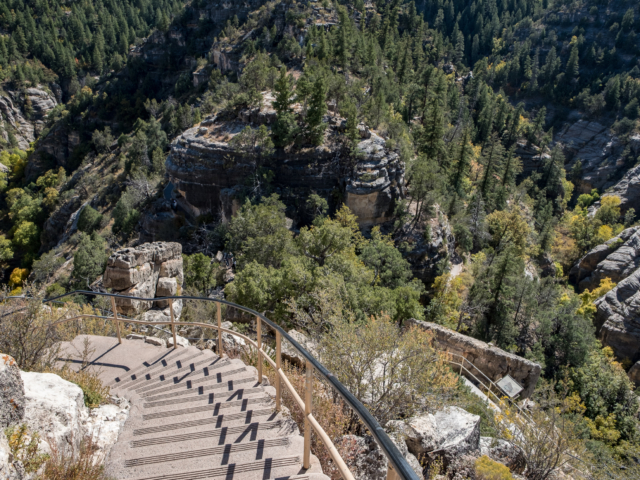Walnut Canyon National Monument is located just ten minutes east of Flagstaff, Arizona, right off historic Route 66 and Interstate 40. This 3,500-acre parcel of land, protected and administered by the National Park Service, is home to lovely Walnut Canyon, where you’ll find the remains of dwellings once inhabited by the Sinagua people. Scientists estimate that these ruins date back to the 12th Century. There are several hiking trails to be explored nearby, and the area is rich in diverse plant life and fascinating geological formations.
Walnut Canyon History and Background
Walnut Canyon National Monument was created in 1915 for the purpose for ensuring the preservation of the unique wildlife, geological formations, and archaeological remains found in the area immediately surrounding Northern Arizona’s beautiful Walnut Canyon. The National Park Service oversees the area today, ensuring that this special site may be enjoyed by generations to come.
And indeed, there’s much to see and enjoy within the boundaries of Walnut Canyon National Monument, including an extensive array of plants, animals, and rock formations. Still, for many visitors, the real draws here are the approximately two-dozen different cliff-dwelling structures that have been a rich source of our contemporary knowledge about the ancient people of the Southwest. Archaeologists date these ruins to some time between the 12th and 13th centuries, and consider them to be among the best-preserved ancient sites in the entire region.
What’s at Walnut Canyon
Visitors to Walnut Canyon National Monument will want to consider beginning their trip at the Visitor Center. There you’ll find an assortment of helpful information and useful amenities. The Visitor Center itself is designed in such a way that its lobby offers up splendid views of Walnut Canyon and the surrounding mountains. You’ll also encounter here a small museum, complete with artifacts from the area, as well as a bookstore, restrooms, and a pleasant picnic area. National Park Service rangers are always on duty, too, ready to answer your questions and/or lead a guided walk.
The real highlights here are Walnut Canyon, Rim Trail, and Island Trail. Walnut Canyon, of course, is the centerpiece of the entire site. The rim of Walnut Canyon—which is where the Visitor Center is located—sits at an elevation of nearly 7,000 feet; you’ll want to have your camera ready, as the rim provides spectacular views of this beautiful region in multiple directions. For those visitors wanting to explore all the sightlines available along the edge of Walnut Canyon, the Rim Trail is for you. This 0.7-mile, round-trip hike takes you through a dense pine forest, alongside a couple cliff-dwelling ruins, and is relatively flat all along the way.
The main dwellings are accessible via the Island Trail. This 0.9-mile, round-trip hike is the more strenuous option (of the two trails), as it descends and ascends sharply in places. However, most visitors say the Island Trail is well worth the effort, as it takes you right beside the remains of nearly two-dozen cliff and cave dwellings. While you’re not allowed to enter any of these structures, you’ll still get great views of them when you go on this particular hike.
For all its natural splendor, Walnut Canyon National Monument is far from remote. In fact, as it is located just ten or so miles from Flagstaff, it is positioned squarely in the general vicinity of a great many Flagstaff attractions and amenities. Plentiful Flagstaff lodging accommodations and dining options are available nearby, as are multiple other popular sites. Additional attractions in the area include Wupatki National Monument, Lowell Observatory, Sunset Crater Volcano National Monument, Riordan Mansion State Historic Park, Museum of Northern Arizona, and many more. Farther afield, you’ll find all the wonders of Grand Canyon National Park and lovely Sedona, Arizona.
Tips for Visiting Walnut Canyon
- The area around Walnut Canyon is well-known for its quite varied, often extreme weather. During summer, temperatures routinely approach 100 degrees Fahrenheit—yet any time during the rest of the year, including Spring, significant snowfall is common. Strong winds are a routine feature of the region, and the weather in general can change in a hurry. All this means it is a good idea to dress in layers while visiting Walnut Canyon National Monument, and be prepared for drastic weather shifts.
- The Visitor Center is open every day of the year except Christmas between the hours of 9:00am and 5:00pm.
- Some of the roads in Walnut Canyon National Monument, including those directly around its Visitor Center, are a very tight for vehicles that are towing any sort of other vehicle, home, cargo, etc. As a result, it is recommended that all vehicles entering Walnut Canyon National Monument adhere to a maximum length of 40 feet.
- Pets are permitted to be in the parking lot of the Visitor Center, as well as the entirety of the Rim Trail—so long as they are kept on a leash. Pets are not allowed on the Island Trail or inside the Visitor Center.




